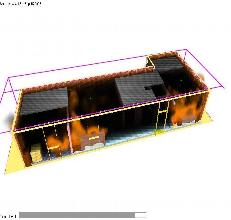Services | Fire Protection Engineering
What is fire engineering?
Performance-based fire engineering is the use of fire science, engineering, analysis including computer simulations and commonly recognized reference, to provide fire safety precautions tailored to each design by:
- Identifying hazards and fire scenarios
- Setting acceptance criteria
- Defining alternatives
- Carrying out analysis to demonstrate acceptability of alternatives, based on a fundamental understanding of the behavior of fire and human


What are the benefits?
Some of the benefits of using a performance-based fire engineering analysis include:
- Design flexibility
- Cost effective solutions
- Safe designs
- Improved knowledge of loss potential
- Legal supports to fire investigations
- Reconstruction of fire scenes
How is this achieved?
In collaboration with the owners, architects and AHJs, we are able to provide experienced specialist surveyors and fire engineers to analyze proposed alternative designs. We have carried out a range of performance-based fire engineering analyses using the guidance and reference acceptable to authorities having jurisdiction.
Where could you use a fire engineering analysis?
Fire engineering analysis can be used for innovative design features on any buildings, and legal support to fire investigation and fire scene reconstructions.
What does the analysis consist of?
The analysis used is dependent upon the complexity of the specific alternative design being evaluated. Complex designs may require the combined use of computer-based evacuation analysis, evaluation of fire resistance of structure members in addition to the fire modeling tools. The extent of the analysis is determined during the early stages of the design process.
- Fire modeling
There are a number of computer-based fire modeling programs currently in use today. For a specific design, these models can be used in a fire engineering analysis to predict smoke movement and temperature gradients within a particular space. Generally zone models or computational fluid dynamics (CFD) models are used depending upon the complexity of the design.
- Evacuation analysis
Used in conjunction with fire modeling, computer-based evacuation analysis can be used to estimate the allowable safe evacuation time of the occupants within a specific area/building. Comparison of the allowable evacuation time with the time taken for the conditions in the space to become hazardous provides the fire engineer with the confidence that the overall life safety objectives have been achieved.
- Structural member fire resistance evaluation
The application of engineering analysis to building structures is one aspect of fire protection engineering, and performance-based design in particular, that has gaining momentum over the past decade. With the advent of faster, more accessible computing power, it has become feasible to undertake complicated analyses of how building elements, such as columns, beams, girders, and the like, respond to server fire load. It can be used in conjunction with fire modeling and evacuation analysis to demonstrate the level of fire/life safety is equivalent or exceeding.
Summary of benefits
- Encourages design innovation and flexibility by giving engineers the choice of a performance-based method to demonstrate compliance where a complex or innovative design cannot meet conventional prescriptive requirements
- Results in safer design in which there is a more cost effective, focused safety provision, where the precautions are tailored to the actual risk.
- Helps to eliminate ineffective precautions/costs and reduce interruption to business.
- Improved knowledge of loss potential can be achieved by analyzing the actual fire risk and consequences, which can provide valuable information for insurers and help in the decision making process to protect high-asset properties.
- Provides the scientific method as the most appropriate basis for undertaking complex fire investigations.